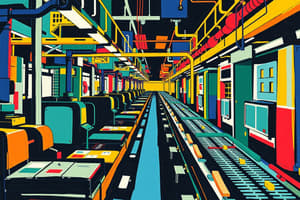Podcast
Questions and Answers
How did Ford reorganize his factory based on Frederick Taylor's principles?
How did Ford reorganize his factory based on Frederick Taylor's principles?
- By reducing the number of workers in the factory
- By introducing complex machinery into the production process
- By timing workers with stopwatches and increasing productivity (correct)
- By making all cars handcrafted with traditional methods
What was the main goal of Henry Ford's Model T production?
What was the main goal of Henry Ford's Model T production?
- To design a high-performance sports car
- To produce a simple and affordable car for rural America (correct)
- To build the fastest car in the world
- To create a luxury car for the upper class
What significant change did Ford introduce in 1913 to speed up car production?
What significant change did Ford introduce in 1913 to speed up car production?
- Introducing moving assembly lines (correct)
- Using only wooden horses for production
- Handcrafting each car with skilled craftsmen
- Increasing the price of cars to make them more exclusive
What distinguishes Vulcan Motor Company from Henry Ford's production methods?
What distinguishes Vulcan Motor Company from Henry Ford's production methods?
How were cars produced before the introduction of assembly lines?
How were cars produced before the introduction of assembly lines?
Flashcards are hidden until you start studying
Study Notes
- In Britain, the Vulcan Motor Company produced handmade cars with skilled craftsmen using traditional methods.
- Charles Hill started as an apprentice at Vulcan Motor Company at age 14, where each man specialized in his job.
- The body shop involved food framing and shaping car panels using armors and a punishing oven.
- Cars were expensive and only accessible to the rich, but this was changing.
- In 1908, Henry Ford aimed to create a simple, affordable car for rural America, the Model T.
- Ford reorganized his factory based on efficiency expert Frederick Taylor's principles.
- Taylor timed workers with stopwatches, increased productivity, and divided tasks into simple repetitive steps.
- Ford introduced moving assembly lines in 1913 wherever possible, allowing for faster production of cars.
- Instead of building cars from the frame up on stationary wooden horses, cars were moved past workers, leading to the birth of the assembly line.
Studying That Suits You
Use AI to generate personalized quizzes and flashcards to suit your learning preferences.




